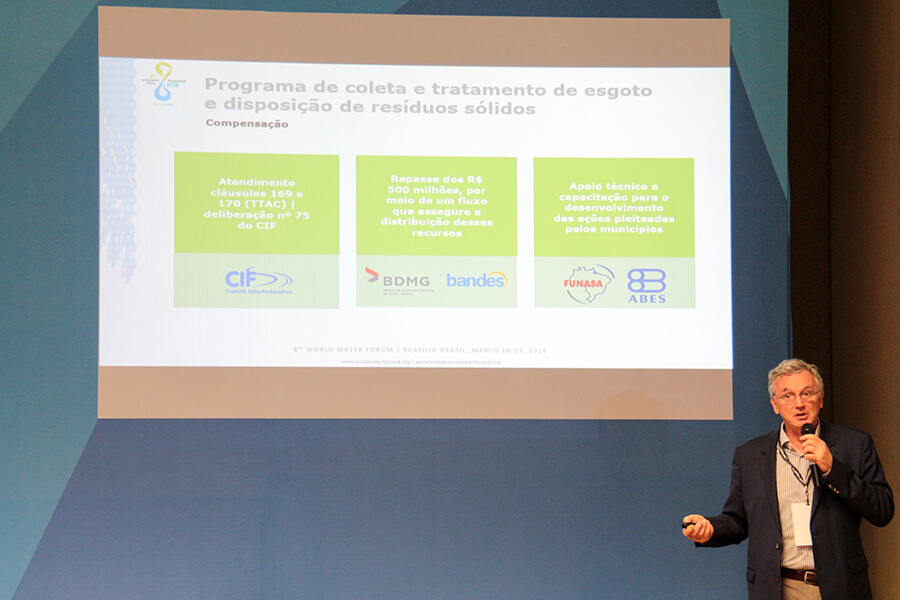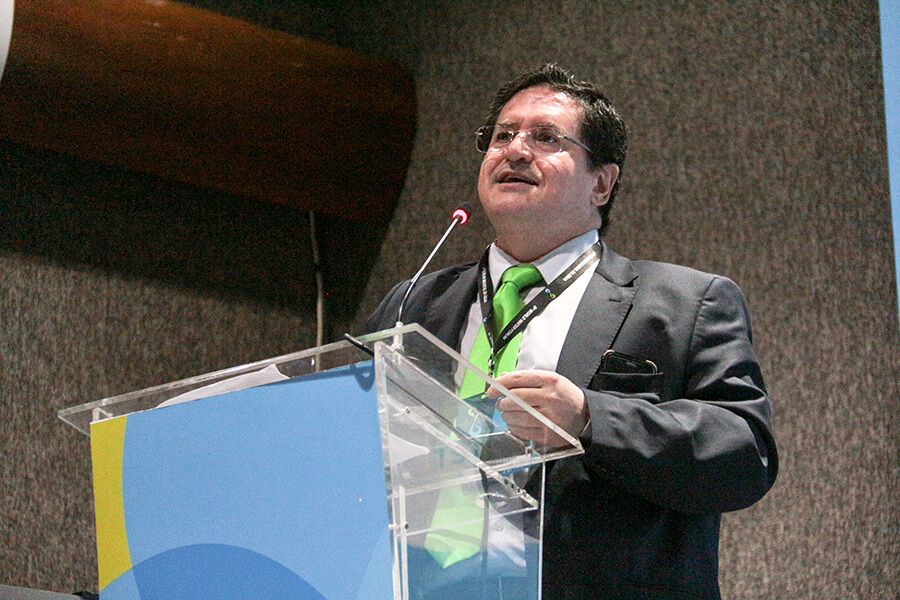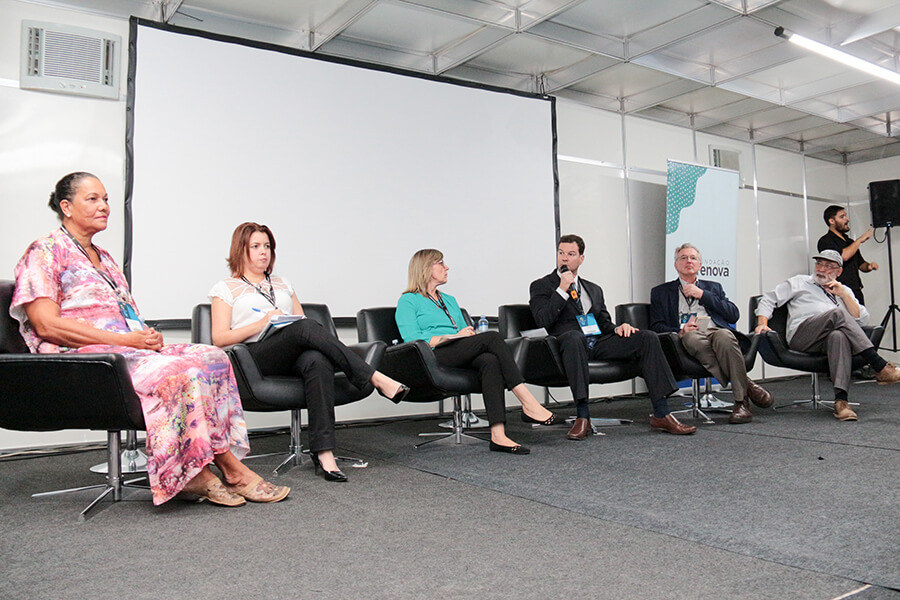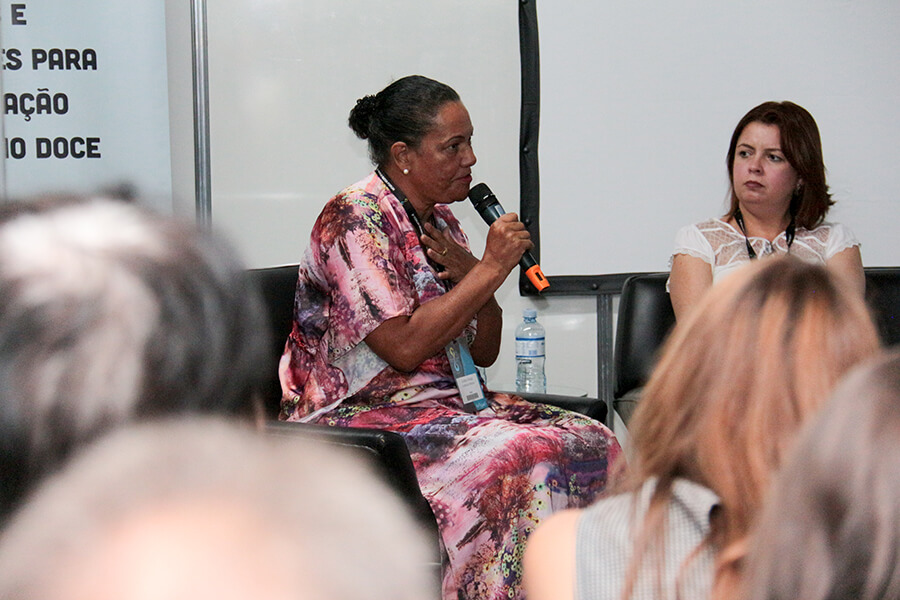Browse Content:
The Mariana disaster from different perspectives
The Renova Foundation governance model
Renova Foundation side event: a meeting to look ahead to the future
“In the river we found unity,” said representative of the Advisory Board
—
In the session “Cases of financial investments in water security”, held this Thursday morning (3/22) during the 8th World Water Forum, cases in Brazil and other countries of the world were discussed related to different ways of investing and managing water projects. Roberto Waack, Head of the Renova Foundation, spoke about the foundation’s experience with the unique governance system adopted in Brazil.
He presented a summary of the Fundao dam collapse, which occurred in November 2015 and had a “significant impact on the local water heritage.” The volume of tailings flowed along the Doce River bed until reaching the sea, resulting in a large tailings deposit along the first 100 kilometers of the watercourse.
This dramatic situation culminated in the creation of the Renova Foundation, which has the objective of executing a set of actions and frameworks according to a Transaction and Conduct Adjustment Term (TTAC) signed between the companies involved in the disaster (Samarco, Vale and BHP) and various government and environmental agencies. “This is an unprecedented system of governance composed of 42 socio-environmental programs,” said Waack.

Roberto S. Waack, Head of the Renova Foundation. | Photo: Released
The program focusing on the treatment of tributaries and sanitation was one of the topics the speaker highlighted. “The compensation front features among its programs an investment for the treatment of sewage and solid residues within the Doce River channel. It needs to be said that about 80% of the domestic sewage along the basin was not treated even before the disaster, that is, the river was already impacted by the sewage,” he said.
Against this backdrop, a series of programs with an investment of 500 million reais were designed to benefit 39 municipalities. “The Renova Foundation has the support of BDMG (Minas Gerais Development Bank) and BANDES (Espirito Santo Development Bank) for the distribution of resources. And how will this resource be distributed among municipalities? For this, we take into account criteria such as the number of inhabitants of each town, the percentage of sewage treated, the level of impact in each area, among other aspects.”
To conclude his speech, the leader of the Renova Foundation indicated the governance system as a primary point to compensate for the damages. “Because there is a mutual governance system, with several organs working together, in which communities and local governments have a voice, the allocation of resources is done in a more efficient way.”
In response to the question about ways to keep the project and investments going in the face of possible governmental changes, Waack said that this is one of the most delicate issues of the repair model. “The basin committee tries to avoid the pulverization of financial resources. It is not about distributing resources, we need to work with transparency and monitoring in the allocation of resources for the maintenance of all activities, avoiding fragmentation.”
Carlos Gonzales, environmental engineer of Petrobras, took advantage of the discussion to present an index used by the company to detect and monitor water risk across the country. “Since 2002, we have been doing studies to assess water availability and risks. We test external tools customized for oil and gas activity. This way we created the Water Stress Index. We wanted this tool to be practical, not to require any studies and ready to be applied quickly.”
Gonzales explained that the index is divided into three main aspects: supply and demand of water in the regions studied (availability index); the variation of the availability; and the capacity of reaction and recovery (resilience index). In this same project, a water crisis button was created. “When pressed, the button flags the availability and vulnerability index and triggers the level of alertness,” explains Gonzales.
This measure has been incorporated in 44 of the company’s installations. This generated a plan for the mitigation of water-related risks, composed of 40 actions. “Petrobras within its corporate standard tries to standardize how the company addresses this issue,” said the engineer.
World Bank’s Joel Kolker, who also attended the panel, clarified the institution’s role in funding environment-related projects. “With respect to water, one of the challenges is to decide on the amount of the investment. Should it be treated as an economic commodity or human right? We are trying to change this debate, “he said.
There are two aspects, according to Kolker, that should be improved in relation to those receiving resources: one is the technical efficiency of the beneficiary, i.e. how the agency receiving the resources must operate, in an efficient and clear manner. Otherwise, says Kolker, “it is difficult for the private sector to get into the discussion.” Another issue is the regulation of the environment, a more political issue that involves not only taxes but institutional arrangements. “For the private sector to act, it is necessary to create a healthy regulatory environment to carry out the transactions,” he said.
The Mariana disaster from different perspectives
Moments after the Fundao dam collapsed, on November 5, 2015, the Brazilian Geological Service (CPRM), a public company linked to the Ministry of Mines and Energy, was activated to monitor the consequences of the tailings that was spreading along the Doce River. Alice Silva de Castilho, the organization’s executive coordinator, was one of the participants in the session “The Mariana disaster: sustainable solutions to restore terrestrial and fluvial ecosystems” and told about the monitoring process that followed the disaster.
“CPRM has been operating in the post-disaster period because it has been operating in the Doce River Basin for over 40 years, in a joint action with the National Water Agency (ANA). The first action was to get the alert system up and warn people to leave the banks of the affected rivers. Then, we developed a turbidity model to guide users to capture water on site,” said the geologist. The monitoring steps included the collection of sediment samples, with 15 teams working in the area, and the laboratory analysis for several parameters.
The mud also passed through towns like Colatina and Linhares, in Espirito Santo, and reached the mouth of the Doce River. “During the process, we used dilution and sediment retention concepts. We defined turbidity ranges to disseminate information,” she said. One of the stages of the process also included geochemical monitoring. “We analyzed sediments in the riverbed, surface water and water supply, we did pH analysis and electrical conductivity”.
Onofre Alves Batista Júnior, Attorney General of the State of Minas Gerais, believes the first thought that came to mind after the disaster was: “Are Brazilian public institutions prepared to deal with a problem of this magnitude? Is there a framework that can solve the problem resulting from an unprecedented environmental crime? ”

Onofre Alves Batista Júnior, Attorney General of the State of Minas Gerais. | Photo: Released
Concern followed about how to proceed with the process to avoid people from suffering and water deterioration. As an immediate measure, the State of Minas Gerais articulated a public civil action against the companies involved. “At that time, no one had any idea about the amount that should be charged for the fine and reparation. We proposed an action of 2 billion reais. Immediately actions appeared from several different organs. We concluded that there is no Brazilian law to prepare for a disaster of this magnitude,” said the prosecutor.
The next step was to reach out to the Brazilian Bar Association (OAB) and technical and environmental bodies to compose a large group and identify ways to solve the problem, including evaluating cases outside Brazil, such as the British Petroleum leak in the Gulf of Mexico. “We decided to align an extensive agreement, since the complexity of the issue was enormous. In this case, it was necessary to give up the traditional solution, that is, to block the company’s resources and constituting funds, because the consequences can completely paralyze economic activity.”
Multiple groups of people affected by the dam collapse expressed their concern about the paralysis of economic activity in the affected region. “The best alternative was to leave the company up and fix the disaster. We reached the conclusion that there was a fundamental need to create a foundation that would take full advantage of existing structures: a governance structure to approve projects, deploy and, if necessary, impose fines.” From this model Renova was born. “The solution given to this case is paradigmatic for the country and serves as a model for other tragedies,” Onofre said.
The Renova Foundation governance model
In his second participation in the Mariana disaster roundtable that day, Roberto Waack analyzed the governance model of the Renova Foundation. “There is no denying the surprising organization of this system unprecedented in the world and in Brazil. More than 70 organizations have come together with the objective of directing, monitoring and raising the debate about the recovery,” he said.
The governance body works together with the Interfederative Committee (CIF), made up of governmental and environmental agencies, which translates the TTAC into actions and frameworks and ensures the allocation of resources. In addition, there is an advisory board that speaks up for those who have been affected, a panel of experts and the trusteeship of the Prosecution Service, whereas the process goes through an independent audit.
“The key point to improve the program is to seek greater participation by those affected. Dialogue with the population is not easy because they associate us with the companies that caused the disaster, “Waack said. Another challenge pointed out by the head of the foundation is the difficulties faced in identifying the people affected and the degree of impact, all in a very informal setting.
“There is a set of emergency actions, but we believe we will leave a legacy of learning and long-term education. We are sure we are on the right track. We also want these actions to continue permanently, such as forest restoration, the joint activities for treating tributaries. At the same time, as we move forward in the short term, we are committed to looking at a more consolidated horizon,” said Waack.
The integrated work of the Renova Foundation with the Doce River Basin Committee was discussed in the same session by Lucinha Teixeira, who chairs the association. A resident of Governador Valadares, one of the towns affected by the collapse of the Fundao dam, she explained how the river basin works and highlighted the plans of the committee, which have been working in the area since the 1990s. “The work is continuous, and we have a strategic plan. It must be said that before the collapse most municipalities located in the area of the Doce River basin had no sewage treatment and were facing water supply difficulties.”
She said that at the time of the Mariana disaster the region was experiencing the worst drought in 40 years. Among the programs of the committee are municipal plans for basic sanitation, rational use of water in agriculture, with an investment of 2.2 million reais, and a program to recover the springs.
“We need to join efforts, but also empower those who were already in the situation. There are several actions taking place. In the integration of these two governance bodies there is a clear moment in which the committees meet. Is the population participating in this process?” Asked Lucinha.
Renova Foundation side event: a meeting to look ahead to the future
The forest engineer and former environment minister, Jose Carlos Carvalho, opened the side event of the Renova Foundation in the late afternoon of this Thursday (3/22), with the report of journalists who, in the 1920s and 1930s, recorded how the region of Doce River basin was different, much greener than the situation we find today. According to the speaker, “the Doce River, like the other basins in Brazil, lived a silent tragedy that evolved over decades and was evidenced and aggravated by the tragedy of Mariana.”

Participants in the session “Challenges and Opportunities for the Revitalization of the Doce River Basin” at the World Water Forum. | Photo: Released
Pastures began to occupy the basin and there was a transition in the timber cycle. “In Galilee I came upon a corral made of rosewood. There was a disorderly process of occupying, a radical replacement of nature,” said Jose Carlos, who considers the Doce River basin to be “the most degraded in the country.”
“I mention this data to highlight what we call a silent tragedy, which unfortunately does not only occur in the Doce River. Long before the Mariana tragedy, what was a source of water became a source of sediment. The channel was completely reduced due to silting,” he said.
After this historical explanation about the basin, Marcelo Belisario, president of the Interfederative Committee (CIF), an organization that works together with the Renova Foundation in the application of environmental and socioeconomic programs resulting from the Fundao dam collapse, spoke about the necessity to deal with such a complex problem in an integrated way. “We could not deal with the legal case, it needed a framework for problem solutions. We have a number of institutions working collaboratively. An executing party was needed; thus, it was decided to create a foundation with financial resources provided by Samarco and its controllers”, he explains.
The Interfederative Committee is a governing body formed by 11 technical boards that take care of 42 programs of social, economic and environmental character. Marcelo affirms that there have been significant advances in the recovery of the area, such as the control of tailings in the region within the mining company. “The agreement is working. Of course, there were mishaps, conflicting situations, but we have a framework that guides us in the sense of performing a series of complex activities and we are following it together.”
“In the river we found unity,” said representative of the Advisory Board
As an important component of this governance system, the advisory board represents social participation in this process of discussing action plans. The person responsible for speaking on behalf of the board at the Thursday session was Maria Auxiliadora de Fatima, born in the town of Rio Doce, which gave its name to the river. “I am a daughter of these waters. We have always used the river without being aware of what it meant to us,” she opened her speech. She highlighted the importance of a sense of collectivity that was created after the Mariana disaster.

Maria Auxiliadora de Fatima, resident of Rio Doce and a member of the Renova Foundation Advisory Board. | Photo: Released
At first, in the heat of the disaster, she says that the population became sad and revolted. “When this tragedy happened, we realized what the river meant in our lives. When the mud came, the smell of dead fish, we suffered a lot. People went to the edge of the bridge to watch the river.” After these feelings, “the groups began to organize, and a sense of community was born to claim the rights that we did not even know we had. We found unity in the river.”
The impacts made the local people organize themselves. In Maria Auxiliadora’s words, it was time to “discuss our rights, deal with the anguish of others, discuss with Renova.” For her, “this is a collective construction, a great legacy.” Roberto Waack, Head of the Renova Foundation, who was also present at the session, was visibly moved by the speech.
Zuleika Torquetti, from the Environmental Department of Minas Gerais, pointed out that “the water can be understood as a sign of how the recovery of the Doce River is evolving.” She commented that the “monitoring system adopted to evaluate the water quality is one of the most modern in Brazil”. Zuleika acknowledged the progress of the program and drew attention to the sanitation program being developed in the region, with an investment of 500 million reais. “We have to learn from this model and innovate it. Among the greatest challenges are the management of tailings and the monitoring of biodiversity. We don’t have a clear understanding of the impact on plants, aquatic and terrestrial species.”
President of the Doce River Basin Committee, Lucinha Teixeira, used her speech to highlight the participation of the committees that have been working in the region since the 1990s. “Several actions were taken to improve the state of the basin before the disaster. We want the actions to last,” she said. “I like to say that in water resource management there has to be collective action, the committee discussion does not have to be political, but should be focusing on technical criteria. We also need to strengthen the partnership to optimize actions,” she added.
